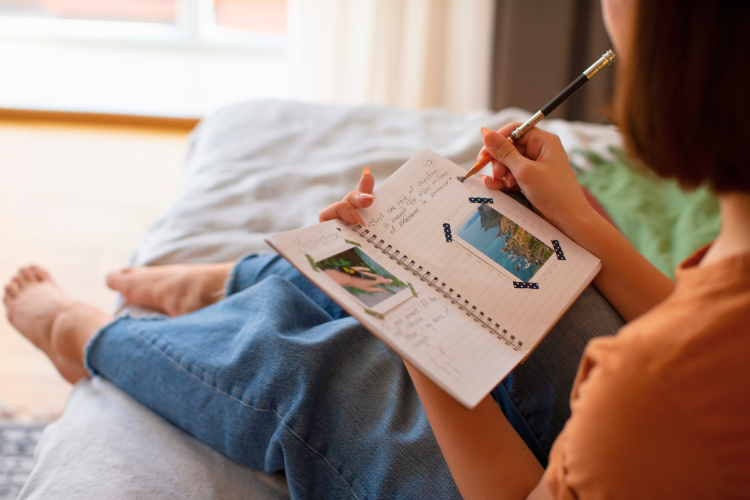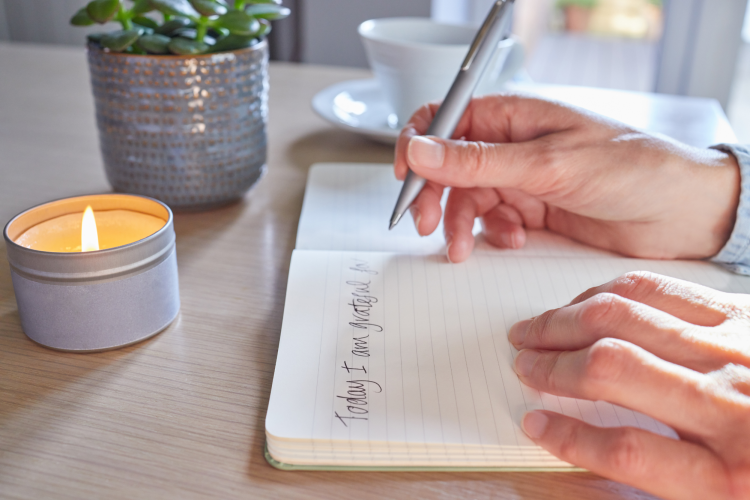Words Of Thanks: How To Start A Gratitude Journal in 2025

One of the best things you can do for your mental health is to make gratitude a regular part of your routine, and the simplest way to begin is by keeping a gratitude journal. Gratitude is simply the appreciation of what is meaningful or valuable to oneself, and the benefits of keeping a gratitude journal are many. One study in the Journal of Psychosomatic Research found that a gratitude journal can improve sleep quality, help you form healthy habits, increase resilience in times of stress by lowering stress hormones, and even improve self-esteem.
If you’ve never kept a gratitude journal before and aren’t sure where to start or what gratitude journal ideas to try, we'll explain everything you need to know to begin.
Jump to Section
- What Is A Gratitude Journal?
- What Do You Write In A Gratitude Journal?
- What Are The 4 A's Of Gratitude?
- Gratitude Journal Benefits
- What Is Gratitude Meditation?
- Gratitude Journal Ideas
- How to Start A Gratitude Journal For Kids
What Is A Gratitude Journal?

A gratitude journal is a diary of sorts where you write down things that make you feel grateful. It doesn't need to be anything big or dramatic. Maybe it's enjoying your morning coffee, hearing your favorite song on the radio or getting a text from a friend that made you laugh. The goal is to notice the good things, those small moments that make you smile or feel peaceful.
When you regularly write down what you're thankful for, something changes. Instead of focusing on what's missing or what went wrong, you start seeing all the good things already present in your life. It's one of those mindfulness activities that seems almost too simple to be effective, but it really does make a difference in how you feel every day. You might be surprised at how this one small habit can genuinely improve your mood and overall sense of well-being.
What Do You Write In A Gratitude Journal?

Getting started with a gratitude journal is easier than you think, and there's no perfect way to do it. Ideally, you should start each entry with the date; this helps you look back and remember what was happening in your life at that moment. Then jot down three to five things you're thankful for.
Use whatever format works for you, whether that’s the notes app on your phone, a dedicated app, a computer document or a physical notebook. Choose a journal you love by selecting one that makes you happy when you see it sitting on your nightstand or desk. If it looks appealing, you're more likely to use it regularly. The important part is writing it down rather than just thinking about it. Whether you're grateful for something huge or tiny, the point is to recall positive moments and let yourself feel the happiness they bring.
Remember to set the scene before you start journaling. Find a comfortable spot where you can focus without distractions and make it feel special. You could light a candle, brew some tea, or find a cozy corner to make your designated gratitude space.
Try your best to create a routine, because consistency helps build the habit and makes practice permanent. Pick a schedule that works for you and stick with it as much as possible. Here are a few additional notes on what do focus on when writing in your gratitude journal.
1. Be Specific

Get specific with your gratitude. Instead of writing "I'm thankful for my friends," try "I'm grateful that Sarah listened to me vent about work for an hour yesterday." The more details you include, the more powerful the practice becomes.
2. Quality Over Quantity
Quality beats quantity every time. Writing deeply about one or two things creates more positive impact than quickly listing ten items. Take time to explore why something matters to you.
3. Focus On People
Focus on people when possible. Expressing gratitude for the individuals in your life tends to boost your mood more than being thankful for objects or circumstances. While it's fine to mention the same people or things repeatedly, find fresh angles and new details each time so your practice stays engaging.
4. Consider What's Lacking

Think about what's missing. Imagine your life without certain people, opportunities or experiences. This helps you appreciate what you have instead of taking it for granted. Also acknowledge the bad situations you managed to avoid or overcome.
5. Count Your Blessings
Treat blessings like presents. When you view good things as gifts rather than things you're entitled to, you appreciate them more fully and enjoy them in the moment.
6. Highlight the unexpected
Surprises and pleasant shocks create stronger grateful feelings, so make note when something catches you off guard in a positive way. Don't overthink it. Simply spend a few minutes listing what you appreciate, whether from your day or your life in general. "My morning coffee was perfect" counts just as much as "I got promoted at work."
What Are The 4 As Of Gratitude?

Practicing gratitude isn't necessarily about forcing yourself to be positive all the time or pretending everything's perfect when it's not. Real gratitude is much deeper than that. It's about genuinely noticing the good things that are already in your life, which sounds simple but is actually one of the most challenging and worthwhile habits you can develop.
That's where the Four As of Gratitude come in: Attention, Acknowledgment, Appreciation, and Action. They’re a way to become more aware of what's happening in your life right now.
1. Attention: Actually Notice What's Around You

The first step is paying attention — really paying attention. Most of us go through our days on autopilot, barely registering what's happening around us. We're distracted, busy and our brains naturally focus on problems and potential threats. That was helpful for survival thousands of years ago but now we're just constantly stressed about work emails and daily annoyances.
Gratitude starts when you intentionally look for what's good and we're not talking about big, life-changing events here. It's the small, everyday things like the smell of fresh coffee, a kind word from a friend, or the fact that you have a place to sleep tonight. These gratitude journal ideas about noticing small moments can help train your brain to look beyond what's going wrong.
2. Acknowledgment: Remember You're Part of Something Bigger

Once you start noticing the good stuff, the next step is acknowledging that much of what you enjoy didn't come from you alone. This part can feel humbling. That meal you ate? Someone grew it, packaged it and delivered it. The phone you're using? Countless people designed, built and transported it. We like to think we're completely independent but the truth is we're supported by many people we'll never even meet.
Acknowledging this doesn't diminish what you've accomplished but rather connects you to something larger. It also means accepting that you're not in control of everything. For those of us who prefer to feel in charge, that can be uncomfortable. But genuine gratitude asks us to recognize our interdependence.
3. Appreciation: Actually Feel It

Letting yourself actually feel grateful is one part of the gratitude journaling experience that many people miss. It's one thing to mentally list what's good. It's another to pause and really take it in emotionally. We’re not saying you should fake happiness or ignore real problems in your life. Simply try to make space to appreciate the little things, such as having a comfortable bed, a conversation that made you laugh or the quiet of an early morning.
If you're exploring junk journal ideas or creative ways to capture these moments, allowing yourself to feel them first makes all the difference. Many people struggle with this step. It can feel vulnerable to let positive feelings in. But if you only think about gratitude without feeling it, nothing really changes. You need to engage emotionally with it.
4. Action: Make It Real

Finally, gratitude isn't complete until it moves beyond your thoughts and into the world. This means expressing your gratitude in some concrete way. It could be thanking someone directly, sending a message or simply being more present with the people around you. Without action, gratitude stays abstract. Action makes it real and tangible and small and specific actions usually work best. And here's something interesting: when you express gratitude to others, you benefit just as much as the person you're thanking. It reinforces those positive feelings and actually changes how you interact with your daily life.
Gratitude Journal Benefits

Gratitude is stopping every now and again and appreciating what you have. Studies reveal that if you practice gratitude while going through a difficult situation, it can actually improve your psychological well-being in the long run, which is one of the key gratitude journal benefits that makes this practice so valuable.
Aside from the obvious benefits of turning off our devices to get a good night's sleep, research has shown that physically writing something down is not only an excellent way to remember things but also a way for new thought processes to stick and for new habits to really stay with us. This is why exploring different gratitude journal ideas and finding what works for you can be so powerful. The act of putting pen to paper helps these positive shifts become a lasting part of your life.
What Is Gratitude Meditation?

Think of gratitude meditation as a mental workout where you train your brain to notice and appreciate the good stuff in your life. It's different from just sitting quietly because you're actively thinking about what you're thankful for and using your thoughts and imagination to really feel that appreciation. When you make this a regular practice, it can seriously shift how you see the world. It's like putting on a new pair of glasses that helps you spot the positive moments you might have missed before.
A gratitude journal pairs perfectly with meditation, giving you another tool to capture these positive moments. Together, they're powerful mental health activities that can boost your mood and help you handle daily stress. The cool thing is, this practice can even help you tackle everyday challenges that used to feel overwhelming. Problems that seemed impossible might start to look like opportunities to learn and grow instead.
Gratitude Meditation Approach

If you want to give gratitude meditation a try, here's a simple approach:
First, set a timer for whatever feels right — even five minutes works — and find somewhere quiet where you won't be interrupted. Sit comfortably on the floor or in a chair with your back straight. You can close your eyes or just soften your gaze.
Begin by setting an intention. This could be something like: "May I find peace. May others find peace too. May we all experience more joy and less suffering."
Take a few deep breaths and let your body relax with each exhale. Now imagine a warm, glowing light starting in your chest and slowly spreading throughout your whole body. This light represents all the gratitude you feel for your life and it might give you a warm, peaceful feeling. You can also picture someone special and send that grateful energy their way.
When you're done, take a moment to appreciate what you just did for yourself. Think about how this little practice might bring more kindness and happiness into your day and the world around you.
The beauty of gratitude meditation is that there's no single "right" way to do it. Whether you prefer gentle movement, visualization or simple affirmations (Louise Hay is the queen of affirmations if you need some guidance), what matters most is finding what works for you and focusing on those feelings of thankfulness in a way that feels natural and sustainable.
Appreciating the Little Things: Gratitude Journal Ideas

Your gratitude journal is all about you and what matters in your world. Nobody else can decide what deserves a spot on your pages. It’s entirely up to you and what's happening in your life right now. But if you're sitting there staring at a blank page, wondering where to start, we've got some friendly nudges to help you along.
- Jot down five little ways you could spread some gratitude around today.
- Think of someone who really matters to you and write about them and what makes them special.
- What talents or skills do you have that make life easier or more fun?
- Is there a tough situation you're dealing with? Try finding one silver lining in it.
- Compare where you are now to this time last year. What good changes can you celebrate?
- Which activities or hobbies would leave a hole in your life if they disappeared?
- Name five parts of your body you appreciate and explain why each one matters.
- What do you love about living where you live?
- What everyday things do you barely notice anymore but would really miss?
- Think of five difficult people in your life. Can you find at least one good quality in each?
- Which possessions would you grab in a fire (after people and pets, of course) and why?
- What songs or artists lift your spirits? Write about why their music matters to you.
- Who made your week a little easier? How could you let them know you noticed?
- What's your favorite food or meal that always hits the spot?
- Which parts of the natural world do you treasure most? Is it sunshine, rain, trees, oceans or something else?
- What's your favorite part of your morning routine that sets you up for a good day?
- Write a quick note to someone who changed your life in some way, big or small.
- What's one new thing you learned recently that you're glad to know now?
- When did you last laugh so hard you couldn't stop? Write about that moment and feel it all over again.
These gratitude journal ideas are really just starting points. Once you get rolling, you'll discover your own rhythm and what resonates most with you. As you write, feel the emotions that come along with what you’re grateful for. This is what makes gratitude journaling something you’ll actually keep and look forward to. Because when you feel the emotions land in your body, you savor the things in your life that you’re writing about and they’re no longer just thoughts. They are experiences. And this shifts your body’s chemistry and your brain for the better.
How to Start A Gratitude Journal For Kids

Want to help your kids develop a healthy writing habit? A gratitude journal for kids is a wonderful way to do just that. It helps them get better at expressing themselves while also learning to recognize and appreciate the good things in their lives. Plus, you don't need anything fancy to begin.
Any blank notebook sitting around your house will do the trick. Though if your little ones are feeling creative, why not let them design their own journal using printables? It's a fun activity that makes the journal feel extra special. Grab some basic supplies like pens, pencils, markers and colored pencils, and you're all set.
The routine is simple: spend just a few minutes each day sitting down with your kids to explore their thoughts and feelings. Now, we know that some kids find writing a bit dull and if that sounds like your child, mix things up. Try different art journal ideas like creating collages, easy doodles, sketching pictures or even writing a short song.
The main goal is to keep it fun and focus on being thankful for what they have. Help them think about the people and things in their world. Who matters to them? What makes them happy? Why do these things mean so much? These simple questions can spark some really meaningful conversations.

Here are some helpful gratitude journal prompts and questions to help your kids get into it:
- Think of someone who loves you no matter what. How do they show their love? How does being around them make you feel?
- What made you smile this week? Tell the whole story!
- Remember the last time you laughed really hard? What was so funny?
- What's something special about you that you really like, even if others don't notice it?
- Describe the best day you can remember having.
- Who's someone you really admire? What do you appreciate most about them?
- Write a letter to someone you're really glad to know. It could be a friend, family member or teacher.
- What's your favorite place ever? Paint a picture with words. Why are you happy this place exists?
- When did you last enjoy some quiet time alone? What were you up to?
- What was the best part of today? Why did it stand out?
- When did you last say "thank you" to someone? What were you thanking them for?
- Who's always there when you need help? How have they helped you before?
- Who's your favorite musician or singer? What makes their music special to you?
- What's your favorite activity during the day? What makes it so enjoyable?
- What gets you excited when you wake up each morning?
- Who's your best friend? What's the coolest thing about them?
- Think of a tough situation you got through. How does it feel knowing you made it past that challenge?
- What do you know about where your family came from? What's something you appreciate about your background?
- What's a tiny thing at school or home that makes you happy?
When things feel really dark, finding the positive things you're grateful for can be the thing that helps pull you out of that and lift you up during a really challenging time. When writing in your gratitude journal, don't overthink it and don't judge yourself. If you've written the same thing 10 days in a row, take it as a sign that you have positive things coming into your life and that's a good thing. And just like different workouts target different muscles, different mindfulness practices like keeping a gratitude journal strengthen your brain in specific ways and make life a little brighter.
A great way to make it a habit that sticks is to tag it onto something you already do. For instance, if you already have a morning routine, you can add it to that, helping it become automatic. You can easily write between three and 10 things to keep it manageable. If you're looking for bullet journal ideas, a gratitude section is one of the simplest and most impactful pages you can create. And it makes a meaningful self care gift for anyone who could use a little more positivity in their life.
For even more ideas to practice everyday gratitude, check out other experiences happening on Classpop!

